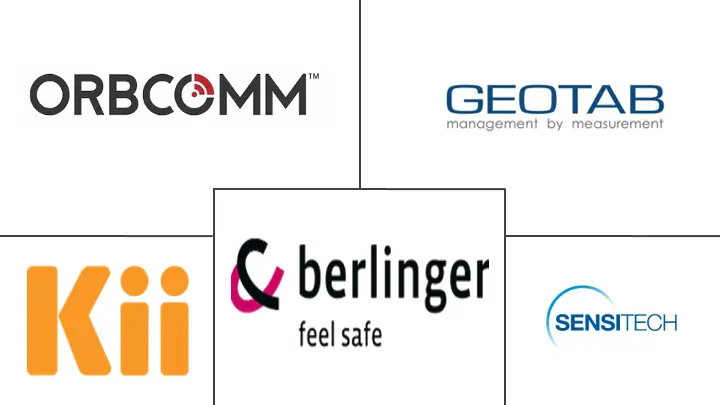Smart Food Logistics Market Size and Share
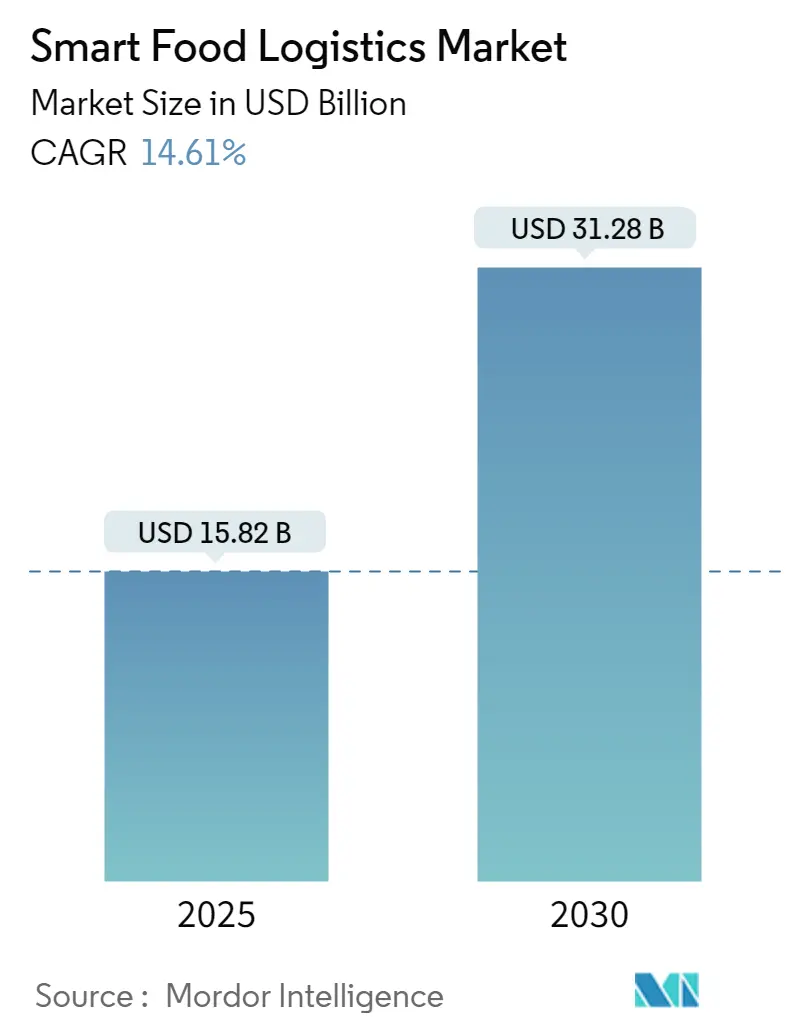
Smart Food Logistics Market Analysis by Mordor Intelligence
The Smart Food Logistics Market size is estimated at USD 15.82 billion in 2025, and is expected to reach USD 31.28 billion by 2030, at a CAGR of 14.61% during the forecast period (2025-2030).
There is a rising trend of utilizing cold chain monitoring technologies by smart food logistics companies, especially to assist food makers in managing the transport, storage, and distribution of temperature-controlled products. Temperature changes caused by traffic jams, mechanical problems, and other things can ruin and make unsafe food that hasn't been preserved, which is a big reason why the market is growing so quickly.
- As the digital economy expands, IoT technology has evolved from a futuristic idea to a practical tool for logistics companies to use in their supply chains. Sensors and IoT tools are changing traditional asset tracking toward intelligent supply chains that can generate a higher ROI for logistics firms. These IoT-enabled sensors provide real-time information on asset or fleet location, fleet mobility speed, temperature conditions, and other critical data sets for the food industry.
- Also, the tight integration of warehouse, transport, and end-consumer information and transparency through the supply chain has been made possible by logistics and technology, along with cloud-based collaborative solutions that extend through the entire supply chain. This, in turn, has been recognized as a key driver of the growth of the market under study. Also, different food laws and regulations in different areas, like the Food and Drug Safety Act, put a lot of pressure on supply chains to record more information and be more open, which is a big reason for the market's overall growth rate.
- Moreover, the market is witnessing various strategic mergers, acquisitions, and investments by key players as part of its strategy to improve business and their presence to reach customers and meet their requirements for various applications. For example, on August 20, 2022, the Regional Centre of Excellence against Hunger and Malnutrition (CERFAM) and HELP Logistics signed a Memorandum of Understanding. The main goal was to set up a new platform for collaboration in different areas of technical, scientific, and educational research. The activities of this platform would be aimed at strengthening agri-food value chains and the overall resilience of communities in Africa to socio-economic shocks.
- But different levels of complexity in the overall installation processes could slow the market's growth over the next few years.
- The COVID-19 pandemic significantly interrupted practically all end-user industries worldwide, disrupting company supply chain management owing to remote working circumstances or total lockdown, resulting in the halt of operations. In order to survive the pandemic and keep their operations running smoothly, the disruption caused companies to use technology and digitalization more. As a result, the market is expected to have many growth opportunities over the next few years.
Global Smart Food Logistics Market Trends and Insights
Cold Chain Monitoring to Hold a Significant Share
A cold chain monitoring solution helps food manufacturers manage temperature-controlled items' storage, shipment, and distribution. Incomplete cooling chains caused by mechanical breakdowns, traffic delays, and other reasons result in shifting temperatures, which can influence the spoilage and safety of perishable foods. In addition, a lack of real-time visibility of goods' locations might contribute to an inefficient operating process.
- As a result, the adoption of cold chain monitoring ensures stable temperatures for transporting and storing goods. Technologies like Bluetooth Low Energy (BLE) beacons with temperature sensors enable tracking goods' locations at relevant checkpoints and tracing temperature data continuously and seamlessly during shipment or throughout the supply chain. However, the need to maintain the cold chain throughout the delivery process raised a significant barrier for many producers of perishable goods, artisanal food producers, and farmers with little or no logistical capacities of their own.
- Moreover, rapidly changing food habits have boosted demand for packaged food, and stringent packing and storage regulations have resulted in a power transfer from manufacturers to merchants. The primary reasons propelling automation and technology adoption in food and beverage logistics include processes focusing on zero contamination, precise storage, and high-speed storage and retrieval operations.
- Companies such as Walmart have made considerable investments in automated grocery selection robots. Alphabot picks orders within the warehouse, utilizing autonomous carts to pick frozen and refrigerated groceries stored at ambient temperature. The robot identifies an item, picks it up, and carries it to a workstation for inspection by a staff person. Such industry automation advancements are projected to generate considerable prospects for cold chain monitoring solution adoption.
- As per the Indian Pharmaceutical Association, in 2019, the total size of the cold chain industry in India was around 330 billion rupees (USD 3987307500), and it was estimated to reach 420 billion rupees (USD 5076288000) in 2022. In 2020, it was predicted that India would have approximately 37.4 million metric tons of cold chain storage capacity. Due to the rise in the cold chain industry, the market is expected to witness significant growth opportunities throughout the forecast period.
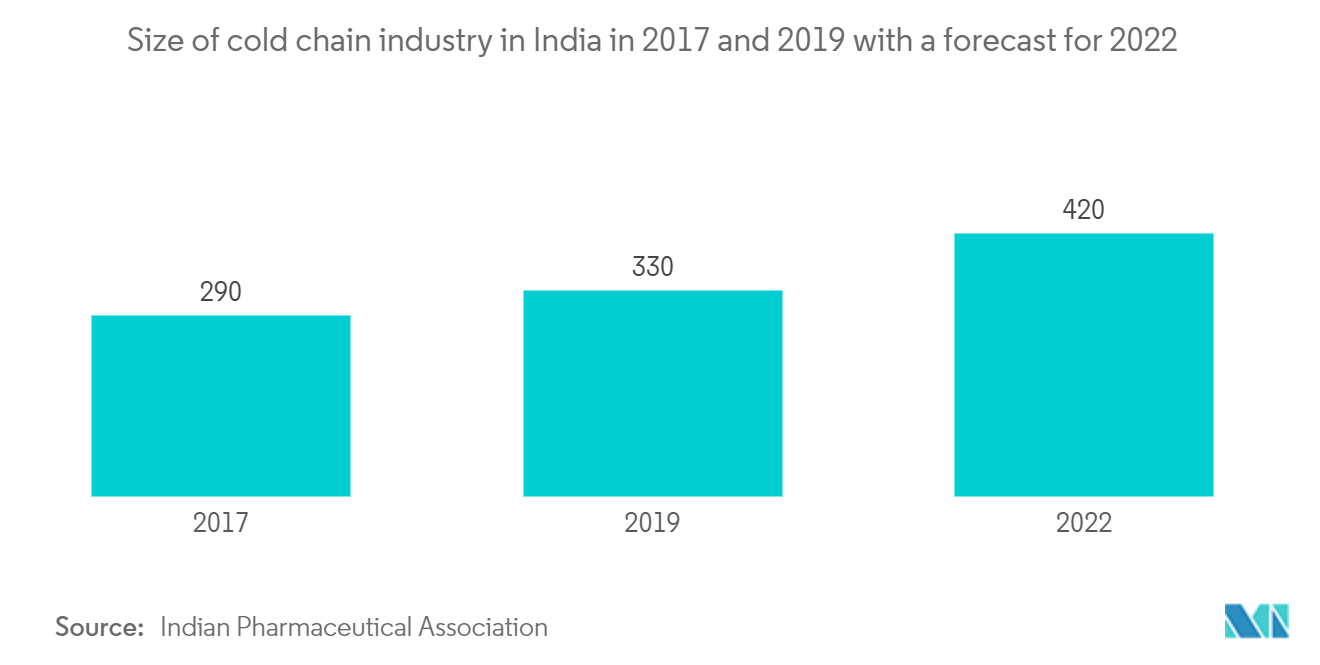
North America Holds Major Share
Because of the presence of many vendors and the growing concern to eliminate waste and optimize resources, the North American region is expected to have the largest share of smart logistics adoption.Moreover, North America is a significant asset tracking market due to the region's strong presence in the manufacturing, transportation, and logistics industries and various technological advancements. Furthermore, government initiatives and policies in different end-user sectors will likely boost regional market expansion.
- The government's drive to adopt technology to reduce waste in the supply chain is fueling the region's market growth. For example, the American Association of State Highway and Transportation Officials, the Federal Highway Association, and local departments of transportation have all supported the adoption of asset tracking in the transportation and logistics industry.
- Moreover, the market is witnessing various significant acquisitions, mergers, and investments by key players as part of their crucial growth strategy to improve business and their overall presence to reach customers and meet their requirements for various key applications. This is expected to open up a plethora of opportunities for the smart food logistics market to expand and improve over the forecast period.
- For instance, in February 2022, U.S. Department of Agriculture (USDA) Secretary Tom Vilsack declared that USDA is making available up to a sum of around USD 215 million in grants and other support to extend poultry and meat processing options, strengthen the overall food supply chain, and create jobs and economic opportunities, especially in rural areas. So, the USDA is very focused on taking steps to increase processing capacity and boost competition in the poultry and meat processing industries. This will make agricultural markets in the United States more competitive, fair, accessible, and stable for ranchers and farmers.
- Furthermore, U.S. Department of Agriculture (USDA) Secretary Tom Vilsack announced in October 2022 that the Department is investing approximately USD 11.1 million, primarily through the Food Supply Chain Guaranteed Loan Program, to assist Crystal Freeze Dry LLC in expanding its capacity to manufacture freeze-dried egg products and creating job opportunities in rural Iowa. The funding is a crucial part of the Biden-Harris Administration's commitment to strengthening the critical food supply chain infrastructure to build more thriving communities for the American people.
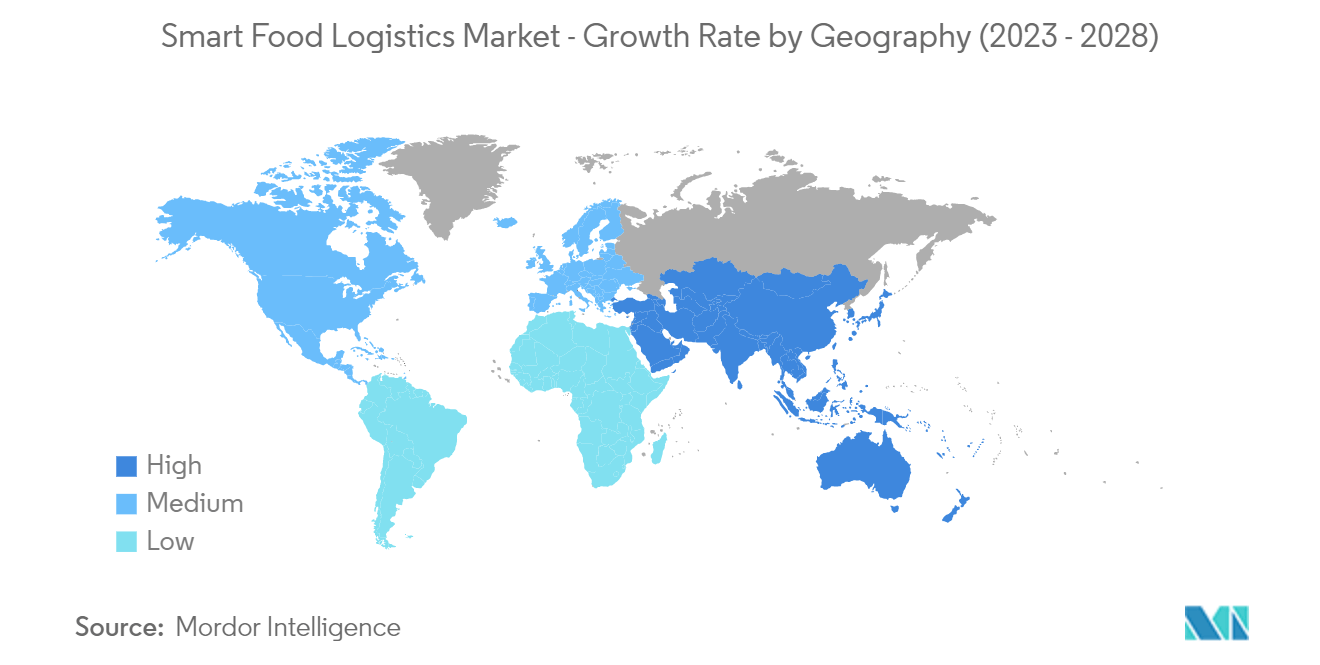
Competitive Landscape
The market for smart food logistics is moderately fragmented. The major players with a prominent share of the market are greatly focusing on extending their customer base across various foreign countries. These companies are leveraging several key strategic collaborative initiatives to maximize their market share and increase their profitability. Some of the key developments in the market are:
In December 2022, DP World, the provider of worldwide smart end-to-end supply chain logistics, and Americold, the provider of temperature-controlled warehousing and logistics, signed a strategic partnership agreement that would enable multi-million dollar investment in a more resilient, efficient, and sustainable global food supply chain. This group wants to help the biggest food companies in the world by setting a new standard for global food distribution, from the farm to the table.
In March 2022, Hill Brothers, Inc., a prominent trucking and logistics provider in the Midwest, will choose ORBCOMM Inc. to supply its integrated dry and refrigerated trailer monitoring solutions for fleet-wide management. ORBCOMM's all-in-one solutions include industry-leading hardware for wireless connectivity and a unified cloud-based analytics platform to streamline operations across multiple asset classes.
Smart Food Logistics Industry Leaders
ORBCOMM Inc.
Sensitech Inc.
Berlinger & Co. AG
Geotab Inc.
Kii Corporation
- *Disclaimer: Major Players sorted in no particular order
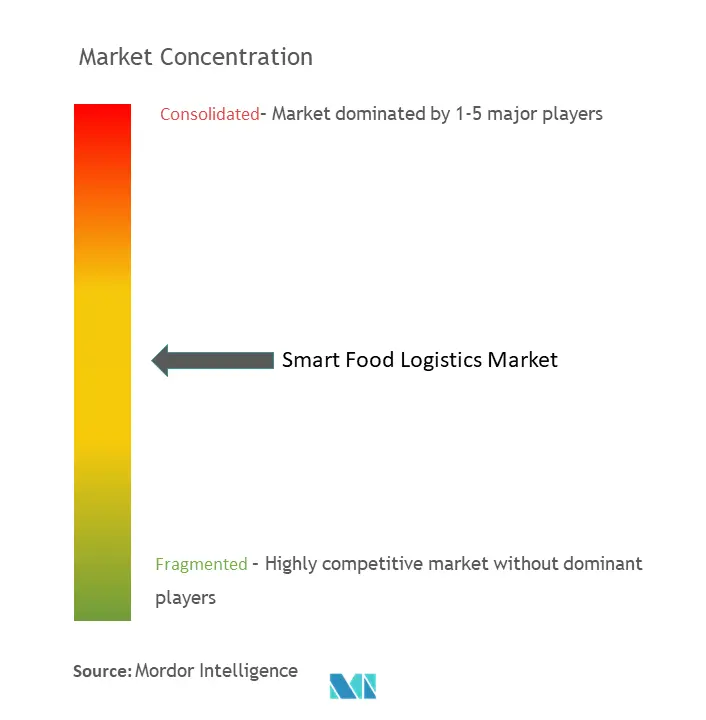
Recent Industry Developments
- April 2022: CoolKit, the largest manufacturer of temperature-controlled vans in the UK, has chosen ORBCOMM Inc. to supply temperature monitoring, management, and compliance for the refrigerated vehicles it offers to customers primarily in the pharmaceutical, healthcare, food, beverage, and agricultural industries. With ORBCOMM's strong temperature recorder solution, CoolKit can prove a continuous cold chain, reduce its carbon footprint by encouraging eco-friendly driving, and improve the efficiency of its administrative operations and workflow.
- March 2022: ORBCOMM Inc. announced the launch of their CT 3500 IoT telematics device, which enables end-to-end, remote view and control of containerized assets and shipments on land, rail, and sea. ORBCOMM's data-driven refrigerated container solution improves functionality, analytics, connectivity, and interoperability with third-party telematics devices to help shippers and carriers around the world improve reefer container logistics.
Global Smart Food Logistics Market Report Scope
The ability to get fresh food items while having real-time access to food motion is smart logistics enabled by the Internet of Things. The current market study examines major smart logistics solutions used to optimize food supply chains, such as fleet management solutions, asset tracking solutions, and cold chain monitoring solutions.
The smart food logistics market is segmented by component (hardware, software, and services), technology (fleet management, asset tracking, cold chain monitoring), and geography (North America, Europe, Asia-Pacific, Latin America, the Middle East, and Africa). The market sizes and forecasts are provided in terms of value (USD million) for all the above segments.
| Hardware (Sensors, Telematics, Networking Devices, etc.) |
| Software and Services |
| Fleet Management |
| Asset Tracking |
| Cold Chain Monitoring |
| North America |
| Europe |
| Asia-Pacific |
| Latin America |
| Middle East and Africa |
| Component | Hardware (Sensors, Telematics, Networking Devices, etc.) |
| Software and Services | |
| Technology | Fleet Management |
| Asset Tracking | |
| Cold Chain Monitoring | |
| Geography | North America |
| Europe | |
| Asia-Pacific | |
| Latin America | |
| Middle East and Africa |
Key Questions Answered in the Report
How big is the Smart Food Logistics Market?
The Smart Food Logistics Market size is expected to reach USD 15.82 billion in 2025 and grow at a CAGR of 14.61% to reach USD 31.28 billion by 2030.
What is the current Smart Food Logistics Market size?
In 2025, the Smart Food Logistics Market size is expected to reach USD 15.82 billion.
Who are the key players in Smart Food Logistics Market?
ORBCOMM Inc., Sensitech Inc., Berlinger & Co. AG, Geotab Inc. and Kii Corporation are the major companies operating in the Smart Food Logistics Market.
Which is the fastest growing region in Smart Food Logistics Market?
Asia-Pacific is estimated to grow at the highest CAGR over the forecast period (2025-2030).
Which region has the biggest share in Smart Food Logistics Market?
In 2025, the North America accounts for the largest market share in Smart Food Logistics Market.
What years does this Smart Food Logistics Market cover, and what was the market size in 2024?
In 2024, the Smart Food Logistics Market size was estimated at USD 13.51 billion. The report covers the Smart Food Logistics Market historical market size for years: 2019, 2020, 2021, 2022, 2023 and 2024. The report also forecasts the Smart Food Logistics Market size for years: 2025, 2026, 2027, 2028, 2029 and 2030.
Page last updated on:
Smart Food Logistics Market Report
Statistics for the 2025 Smart Food Logistics market share, size and revenue growth rate, created by Mordor Intelligence™ Industry Reports. Smart Food Logistics analysis includes a market forecast outlook for 2025 to 2030 and historical overview. Get a sample of this industry analysis as a free report PDF download.
